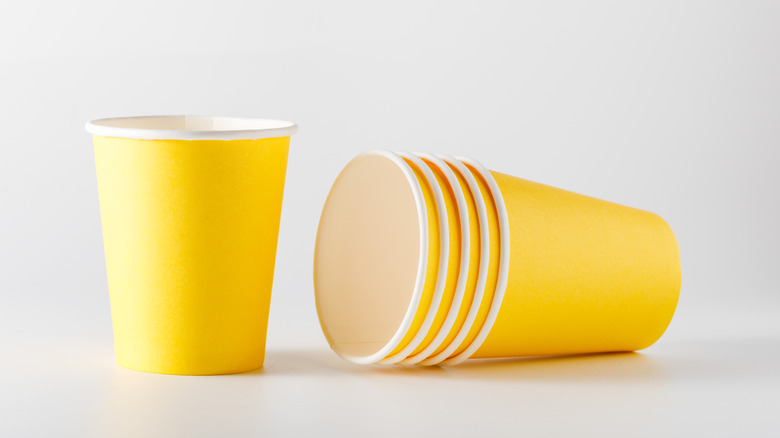Does The Yellow Cup Hack Help Prevent Aphids From Destroying Tomato Plants?
So, who hasn't seen aphids in their garden? If you haven't, count yourself lucky because aphids are among the most common garden pests. Their widespread distribution and ability to infest a wide range of plants -– including roses, beans, cucumbers, and tomatoes — contribute to their commonality. However, since tomatoes are particularly susceptible to aphid infestations, gardeners trying to cultivate these plants end up feeling frustrated. Enter the yellow cup and petroleum jelly hack -– a method that's said to help get rid of aphids in tomato gardens. But does it really work?
Tomato plants are like a gourmet feast for aphids who love feeding on their succulent leaves and stems. These pests not only weaken the plants by draining their sap but also transmit diseases, stunting growth and reducing yields. Signs of an aphid infestation on tomato plants include curling leaves, sticky honeydew residue, and the presence of ants, which farm aphids for their sweet secretions. One reason for the ubiquity of aphids is their adaptability. They thrive in temperate climates but can also survive in warmer or cooler regions. Plus, aphids are not limited to outdoor gardens; they can also infest indoor plants, making them a year-round concern for gardeners. These prolific breeders reproduce rapidly, producing many generations in a single growing season. Their ability to develop resistance to pesticides makes chemical control challenging (and environmentally harmful). So, you can't be blamed if you want to try this yellow cup solution to protect your tomato plants from aphids.
Implementing the yellow cup hack in your tomato garden
Before applying the yellow cup hack, you might wonder: Why yellow? Studies have shown that aphids are highly attracted to the color yellow, a behavior attributed to the insects' visual sensitivity to certain wavelengths of light. By using yellow cups coated with petroleum jelly, you can lure aphids away from your crops. To make this anti-aphid solution, smear some petroleum jelly on the outer section of a yellow plastic or paper cup. Put the trap upside down on a stake or post, securing it with a nail, pin, or tack. The sticky surface traps aphids as they land on the cup, preventing the bugs from reaching your tomatoes. Of course, a significant limitation of this method is that it only ever works on flying aphids. Moreover, sticky traps can inadvertently catch beneficial insects as well.
To eliminate all types of aphids effectively, you can use a homemade spray made with castile soap and water or tomato leaf and boiled water, which could be your secret weapon to repel aphids from your garden. Various studies on the effects of tomato leaf extract on aphids, including one study initially published in the International Journal of Advanced Research, have proven its efficacy in eliminating them. Companion planting (which will attract beneficial insects) and manual inspection and removal also help keep aphids and other pests at bay, ensuring a bountiful harvest of the best, pest-free tomatoes in your garden.

